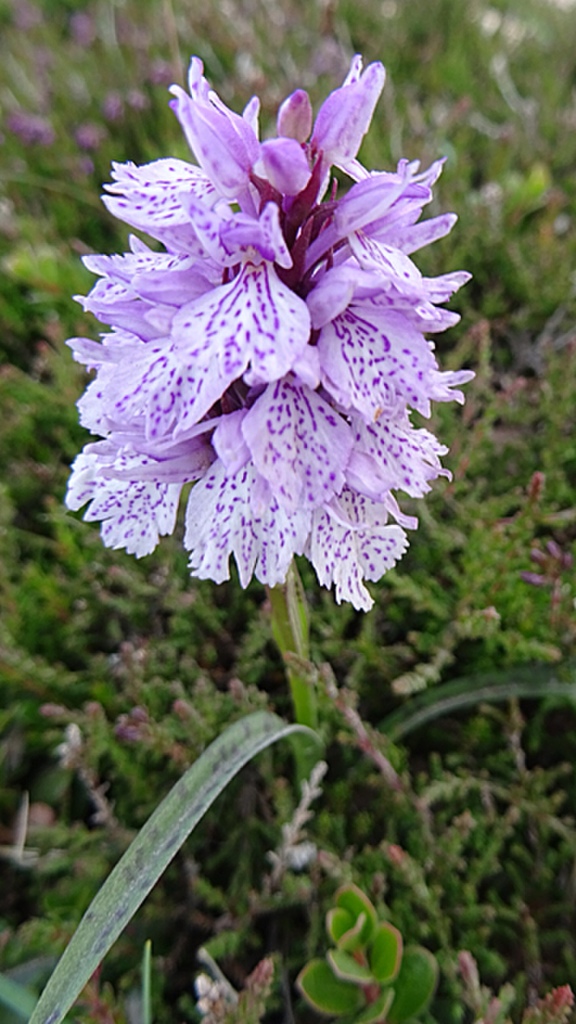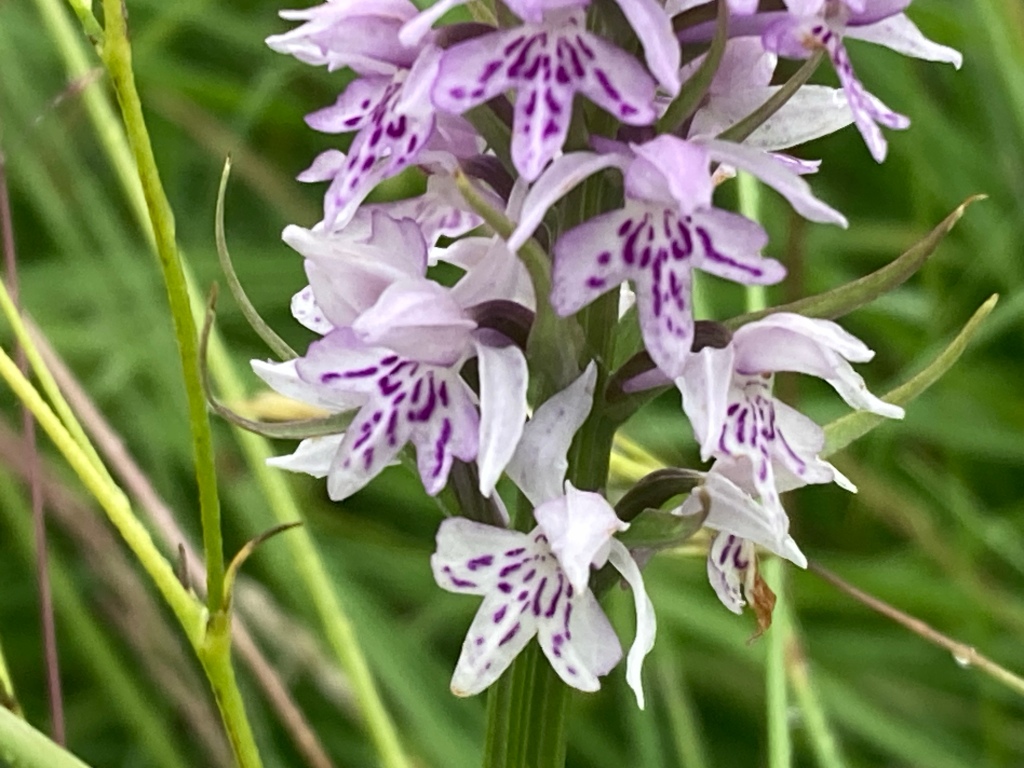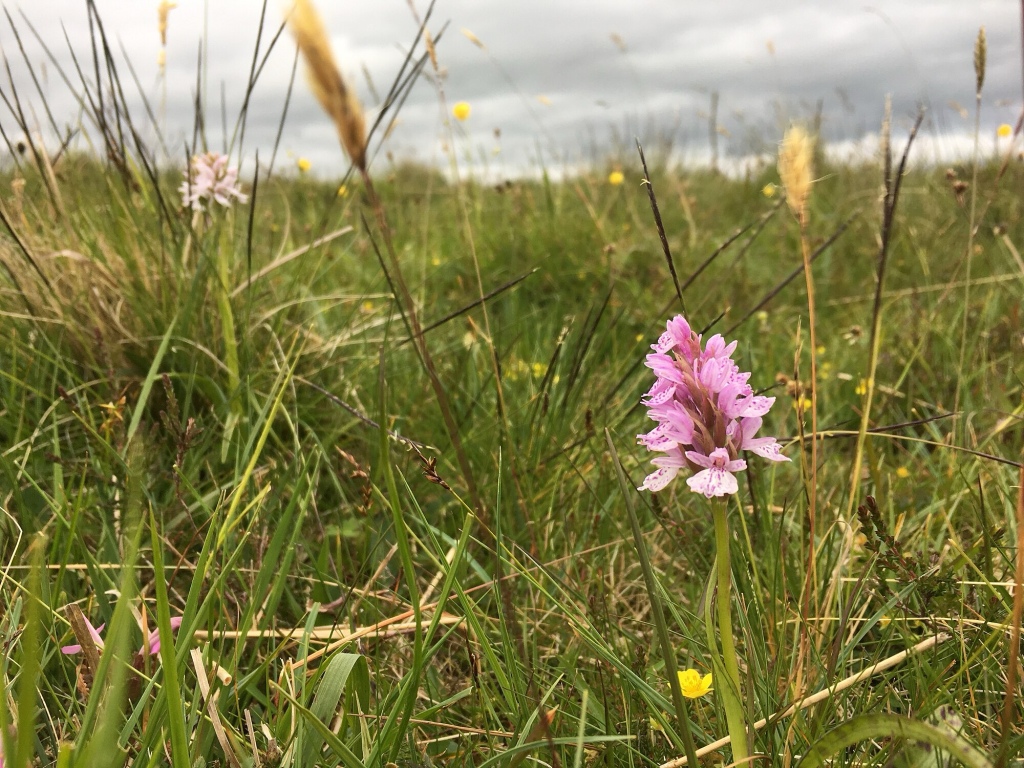
The Heath Spotted-Orchid, Dactylorhiza maculata, is one of the most common orchids in the British isles and one of our prettiest upland meadow-flowers. They can be found from May through to August, and grow on damp grasslands, heaths and moors, preferring acidic soils.
Like many orchids, the Heath Spotted-Orchid can be variable in colour, but its flowers are usually a pale pink with purple spots and streaks, though they get their common name not from their flowers but from their narrow, pointed leaves, which usually have dark spots.

Pollinator appeal
They grow upright to a height of around 10 to 30cm and develop a dense, sweetly-perfumed flower-spike, composed of up to 40 individual flowers, that is very attractive to bees, such as the Red-tailed Bumblebee, which pollinate their flowers. They have evolved a flower which looks as appealing to pollinating insects as it does to us, with patterning additional to that which we can see that can only be seen by insects which can perceive ultraviolet light.
The lower lip of its flower has three lobes, with the centre lobe being smaller than the other two, and this is the easiest way to distinguish the Heath Spotted-Orchid from its similar looking cousin the Common Spotted-orchid as, though the Heath Spotted prefers more acidic ground, the two species can often be found growing side-by-side and hybrids often occur.
The pollen bearing stamens of the flower are positioned so they stick to the heads of visiting insects and deposit pollen on them. This pollen is then taken by the insect to another flower where it rubs off onto the stigma, thus pollinating the plant, however the visiting insects get very little, if any benefit from this arrangement as, like many other orchids, the Heath spotted is a taker rather than a giver as it doesn’t produce any nectar.

Floral fecundity
Orchids can be very slow-growing plants and some species may take several years to reach their flowering stage, their seeds are also amongst the smallest in the whole plant kingdom. The Heath Spotted’s tiny dust-like seeds, which they produce by the thousands, are scattered by the wind and have no food reserves, to germinate they rely upon a type of fungus which the orchid uses to provide nutrients.
Charles Darwin once, when pondering upon the fecundity of nature, estimated that if all of the seeds carried by a single Heath Spotted-orchid germinated, it would cover an acre with its progeny, in the following year its grandchildren would cover an area the size of the isle of Anglesey, and in the next year its great-grandchildren would cover the whole surface of the earth with a uniform carpet of green and purple.
Heath Spotted-Orchids are perennial plants and remain dormant throughout winter, with their tubers, stems and buds all hibernating underground. Its scientific name; Dachtylorhiza maculata, comes from the shape of these tubers, with dactyl meaning ‘finger’ and rhiza meaning ‘root’, the second half maculata meaning ‘spotted’, refers to the spotted pattern on its flowers.

Mapping the Meadow
By Alice Uren
Joyous whilst wistful midst bountiful swathes of summer stalks
inquiring in the delicate detail
happy down-to-earth daisies comfortable in the company of lofty crowns
velvet sedge heads, varied vetch, great burnet
taking you there to….
the thrill, the trill
a curlew’s call; take care amongst the ground nests of honey brackened grass
breathe, and be
eyebright amongst happy thoughts of the melancholy thistle
rattle, ruffle amongst yellow bobbing buttercups and wildflower tops
sway, swathe, dance deeply with the warm red sedge
cavort in crimson poms and puffs of clover
high to the clouds of papery blue butterflies and upward facing orchids
dear sweet meadow sigh,
scythe
slow
wind down to coronation bales
rest, self heal rest amongst the melancholy thistle
dream in the majesty of the mist-shimmering meadow
rest
breathe your dream and heartened delight
(From the Wildflower Way with Words)
A B-H